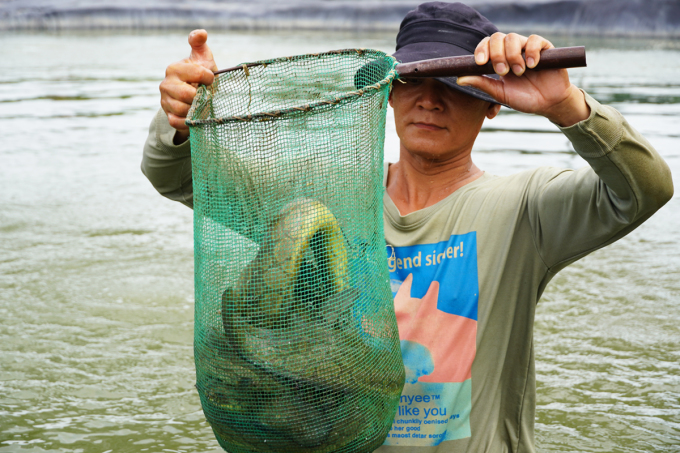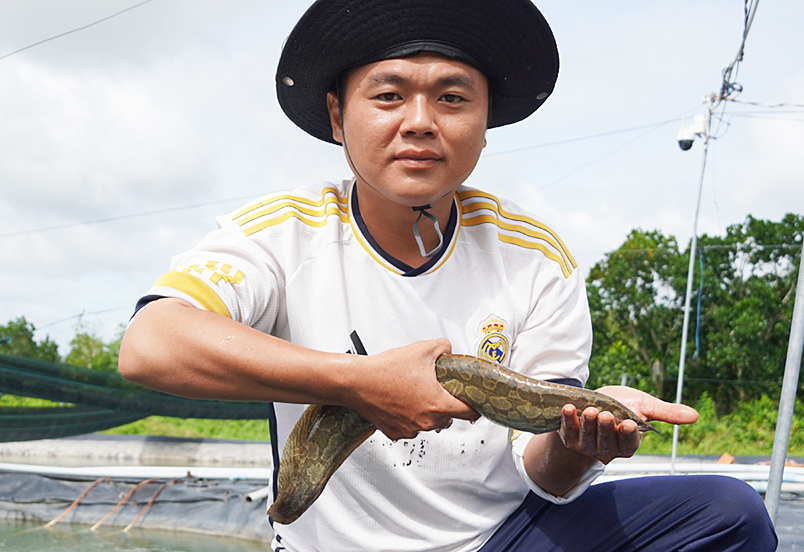Tien GiangCurrently working in the pharmaceutical industry in Ho Chi Minh City, Vo Le Hoang Tuan returned to his hometown to raise loach, koi fish, and earthworms, earning about 800 million VND per year.
At noon in mid-September, the 5,000 m2 fish pond of Mr. Tuan (32 years old, Hamlet 3, Thanh Loc Commune, Cai Lay District) echoed with the sound of an oxygen machine. Under the pond, workers were diving to scoop up bundles of plastic pipes where the fish were hiding, pouring them into nets for harvesting.
Fat loach fish, as big as a wrist and weighing about 500 grams, are put into oxygenated glass tanks waiting to be delivered to customers. “It took a lot of effort to convince the family and many failures to get to where we are today,” said Mr. Tuan.

Pharmacist Vo Le Hoang Tuan next to a pond of loach fish raised according to a biosafety model. Photo: Hoang Nam
6 years ago, after graduating from Pharmacy, Tuan worked at a hospital in Ho Chi Minh City. Coming from a rural background, at first he felt quite suffocated by the pace of urban life. Outside of work, the young man spent a lot of time researching his expertise and models of farming and raising livestock in rural areas.
At this time, Tuan had the idea of returning to his hometown to “raise fish and grow vegetables” according to a safe model. However, when he expressed his intention, his family objected, asking him to continue working because no one in his family of four was a farmer, and they were afraid that Tuan would just follow the “trend” and not be able to endure the hardship.
Not giving up, Tuan looked up documents on the Internet to build a model. He found that among the fish species suitable for farming conditions in his hometown, the loach fish, known as “water ginseng”, has high medicinal and nutritional properties.
In early 2019, having saved 50 million VND and found a reputable source of breeding stock in Can Tho City with technical consulting services, Tuan decided to quit his job and return to his hometown to start a business with his family’s 400 m2 garden.
The young pharmacist’s top priority is a model that is both profitable and biosafe, and does not pollute the environment. In addition to the pond, in a corner of the garden, Tuan raises earthworms and grows aloe vera. Water from the pond is used to water the aloe vera, plant waste is used as food for earthworms, worms are used as food for fish, and worm manure is used to fertilize the aloe vera.

Workers use nets to harvest loach fish for delivery to customers. Photo: Hoang Nam
Unlike traditional ponds that only cover the pond walls with tarpaulin and oxygen, Mr. Tuan covers the bottom of the pond with tarpaulin and also builds a net cover system above. This method increases the cost by more than 10%, but helps to overcome the problem of diseases accumulating in the mud at the bottom. In addition, the net cover helps the fish not to be shocked when the weather changes.
He also invested in a pond system to treat both incoming and outgoing water and divided the farming area into many small ponds to better control the spread of disease. From there, the bio-secure farming model will have a success rate of about 80%, double that of the traditional farming model.
In addition, he also mixed koi carp with 50% of loach to get short-term and long-term benefits. The pond owner explained that loach fish can be harvested after 10-12 months of raising, while koi fish can be sold after about 8 months. In addition, as ornamental fish, koi fish are very sensitive to changes in the pond environment. Therefore, if you observe that the koi fish are unstable, you can proactively treat the pond to protect the loach fish.
Despite careful preparation, the first crop, when the fish were about 4 months old, started to encounter problems, 80% of the fish died. Undaunted, Mr. Tuan then went to farms in the West to learn. By the third crop, he began to overcome the limitations and gradually expanded the pond size to 2,500 m2.
Pharmacist Tuan’s farm of loach and koi fish. Video: Hoang Nam
According to Mr. Tuan, raising loach fish is not too hard, but it takes time and requires care like a “baby”. Because this fish likes cleanliness (the water must be changed every 3-5 days) and needs a regular source of oxygen. Every day, the fish eat twice a day, morning and afternoon.
Because loach fish like to live in hiding places, they need a shelter system made of bundles of plastic pipes placed at the bottom of the pond. To keep the fish healthy, it is also necessary to add vitamin C, digestive enzymes and microorganisms to improve the water environment. After many experienced crops, the current loss rate at Mr. Tuan’s pond is no more than 10%.
According to the pond owner’s estimate, with an area of 5,000 m2, the initial investment cost: including pond digging, tarpaulin, cover net, shelter, generator, oxygen machine and pump system, pipes totals about 450 million VND. On average, each year the fish farm sells about 2 tons of loach and 1 ton of koi.
Currently, 0.5-1 kg loach is sold at wholesale price of 250,000 VND per kilo. Koi fish weighing 1.5 kg or more with beautiful standard color are sold at 350,000 VND per kilo. It is estimated that each year, Mr. Tuan earns over 800 million VND, after deducting expenses, the profit is nearly 400 million VND.
Last year, the biosafety loach farming model won first prize in the competition. Youth initiative promotes indigenous knowledge to adapt to climate change Organized by Tien Giang Provincial Youth Union.
Hoang Male




